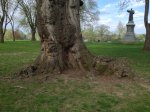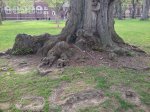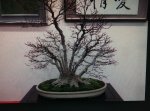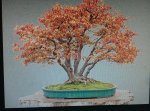You are using an out of date browser. It may not display this or other websites correctly.
You should upgrade or use an alternative browser.
You should upgrade or use an alternative browser.
Multi trunked Maples...
- Thread starter fredman
- Start date
sorce
Nonsense Rascal
Smoke started one over tile.
Check the Bunker!
Sorce
Check the Bunker!
Sorce
barrosinc
Masterpiece
Not over tile... through tile.Smoke started one over tile.
Check the Bunker!
Sorce
here is the link to the bunker: https://bonsaial.wordpress.com/2014/01/12/building-a-giant-based-trident/
you can then choose if you want all but one trunk chopped off or keep more than one.
sorce
Nonsense Rascal
Max! Your my dog!
My Chile Dog!
Sorce
My Chile Dog!
Sorce
Eric Group
Masterpiece
That is the same technique basically, though in this example, he was using it to actually create one large tree with a MASSIVE base instead of the clump style. To creat a clump instead, you can basically do the exact same thing and just not remove the extra trunks.Not over tile... through tile.
here is the link to the bunker: https://bonsaial.wordpress.com/2014/01/12/building-a-giant-based-trident/
you can then choose if you want all but one trunk chopped off or keep more than one.
I am thinking of making a JM like this in the Spring.. @Smoke I hole you will post an update on some of these trees you have done recently if you get a chance! I seem to recall more than one post you made about these kinds of Maple through tile plantings that I have seen you post on the bunker and here over the past year or two.
MACH5
Imperial Masterpiece
Below is another way to make them. This method is very simple but does require time just like anything else in bonsai.
http://teri-gonewalkabout.blogspot.com/2010/05/bonsai-class-kabudachi-maple.html
http://teri-gonewalkabout.blogspot.com/2010/05/bonsai-class-kabudachi-maple.html
LanceMac10
Imperial Masterpiece
Please explain to me how these are started...?
By the person who knows that when he is ready to leave this mortal coil the person he sells it to will be passing it on to the person that is going to then pass it on to the person that will get all the credit!!!
I don't want to say "trunks are easy", but compared to properly tapered primary and secondary branching along with proportionate "twigging".....well, it probably is...
At least you get to start it off and leave a legacy!
Something like...."This wonderful planting was created by,(insert your name here), a pioneer in New Zealand whom, along with his family thru several generations, have advanced the practice of Bonsai cultivation...."
A little schmaltzy...but why can't it happen....
Good luck!!
By the person who knows that when he is ready to leave this mortal coil the person he sells it to will be passing it on to the person that is going to then pass it on to the person that will get all the credit!!!
I don't want to say "trunks are easy", but compared to properly tapered primary and secondary branching along with proportionate "twigging".....well, it probably is...
At least you get to start it off and leave a legacy!
Something like...."This wonderful planting was created by,(insert your name here), a pioneer in New Zealand whom, along with his family thru several generations, have advanced the practice of Bonsai cultivation...."
A little schmaltzy...but why can't it happen....
Good luck!!
GrimLore
Bonsai Nut alumnus... we miss you
Please explain to me how these are started...?
There is a lot of information on clump style. I really would suggest searching on Kabudachi or Kabubuki. I might also suggest you try it with Quince - to "me" they make a great clump in a shorter period of time while you are waiting on the Maples to grow/develop.
Grimmy
M. Frary
Bonsai Godzilla
brewmeister83
Chumono
Woah, that first one looks like they grew out a leader to thicken then never cut it back to profile.... I see two different "crown" outlines on that tree - really jarring. Where did you find that pic?
JoeR
Masterpiece
I am making a few of these too come spring but the real question I have been wondering is how to make that gigantic pancake base you see in japanese gardens....
And what's the best species for pancakes?
And what's the best species for pancakes?
brewmeister83
Chumono
I am making a few of these too come spring but the real question I have been wondering is how to make that gigantic pancake base you see in japanese gardens....
And what's the best species for pancakes?
For Multi-trunk:
http://bonsaibark.com/2009/03/27/an-ingenious-technique/
http://bonsaibark.com/2009/03/31/an-ingenious-technique-part-2/
For "pancake" or "melting" nebari technique:
https://samedge.wordpress.com/2010/12/03/incredible-nebari/
http://bonsaitonight.com/2009/02/14/ebihara/
http://www.bonsainut.com/index.php?threads/ebihara-maples.18215/
Seems the two most used trees for these techniques are traditionally elm or maple although others have been used with success - I'm guessing you need a species that has the ability to fuse back onto oneself readily to achieve this, and those two fit the bill.
Last edited:
Eric Group
Masterpiece
I have often though a Crepe Myrtle would be a good candidate for a pancake nebari like this as well... Maybe I will have a few worth looking at in a couple years. Doing some grafts this Spring to improve the nebari...For Multi-trunk:
http://bonsaibark.com/2009/03/27/an-ingenious-technique/
http://bonsaibark.com/2009/03/31/an-ingenious-technique-part-2/
For "pancake" or "melting" nebari technique:
https://samedge.wordpress.com/2010/12/03/incredible-nebari/
http://bonsaitonight.com/2009/02/14/ebihara/
http://www.bonsainut.com/index.php?threads/ebihara-maples.18215/
Seems the two most used trees for these techniques are traditionally elm or maple although others have been used with success - I'm guessing you need a species that has the ability to fuse back onto oneself readily to achieve this, and those two fit the bill.
Most of the techniques described revolve around tiles and pinning wires into place, but a few thread grafts to a tree with a decent nebari should be able to help develop something similar as well.
brewmeister83
Chumono
I have often though a Crepe Myrtle would be a good candidate for a pancake nebari like this as well... Maybe I will have a few worth looking at in a couple years. Doing some grafts this Spring to improve the nebari...
Most of the techniques described revolve around tiles and pinning wires into place, but a few thread grafts to a tree with a decent nebari should be able to help develop something similar as well.
Sure, placing grafts will help increase root volume, but I think the crux of the technique is you have to line up the roots that are there (via boards/wires/pins) so they are all arranged in such a way so they are guaranteed to fuse as they thicken over time. I think it's just another of those "there is no shortcut to good results" techniques.
Eric Group
Masterpiece
Yep, I am just saying that to get the roots in place TO fuse them, you could do grafts instead of the layer over tile... Might get you there a little quicker.Sure, placing grafts will help increase root volume, but I think the crux of the technique is you have to line up the roots that are there (via boards/wires/pins) so they are all arranged in such a way so they are guaranteed to fuse as they thicken over time. I think it's just another of those "there is no shortcut to good results" techniques.
Personally... I think the huge pancake look is a little too much. I like a spread at the root base, but I think some of these are waaaaaayyyyy too exaggerated and it is no longer visually pleasing to me beyond a point. I'd rather see individual roots spreading from a nice root flair than a huge circular pancake like some of these trees have...
garywood
Chumono
Yep, I am just saying that to get the roots in place TO fuse them, you could do grafts instead of the layer over tile... Might get you there a little quicker.
Personally... I think the huge pancake look is a little too much. I like a spread at the root base, but I think some of these are waaaaaayyyyy too exaggerated and it is no longer visually pleasing to me beyond a point. I'd rather see individual roots spreading from a nice root flair than a huge circular pancake like some of these trees have...

brewmeister83
Chumono
Personally... I think the huge pancake look is a little too much. I like a spread at the root base, but I think some of these are waaaaaayyyyy too exaggerated and it is no longer visually pleasing to me beyond a point. I'd rather see individual roots spreading from a nice root flair than a huge circular pancake like some of these trees have...
I completely agree too. The most pancaked I've ever seen an actual tree get is an elm on the quad of Trinity campus in Hartford. Just looking at the far shot, you can see the ratio of pancake to trunk is waaaaay less then we see in bonsai...



The only real "pancake-ing" occurs where the mowers have run over exposed roots for years - resulting in a widening quasi-melting looking callus.

JoeR
Masterpiece
Thanks, I found the first melting nebari link especially interesting- grafting mature branches on saplings to move elsewhere is quite the idea.For Multi-trunk:
http://bonsaibark.com/2009/03/27/an-ingenious-technique/
http://bonsaibark.com/2009/03/31/an-ingenious-technique-part-2/
For "pancake" or "melting" nebari technique:
https://samedge.wordpress.com/2010/12/03/incredible-nebari/
http://bonsaitonight.com/2009/02/14/ebihara/
http://www.bonsainut.com/index.php?threads/ebihara-maples.18215/
Seems the two most used trees for these techniques are traditionally elm or maple although others have been used with success - I'm guessing you need a species that has the ability to fuse back onto oneself readily to achieve this, and those two fit the bill.
Eric Group
Masterpiece
Gary, I wish this was a bigger pic! Is that an update of one you posted on your blog? Why don't you update it any more? I'd love to see some pics of some of your trees from the blog today!I tend to agree with you Eric but knowing techniques helps to grow or improve our trees. Aesthetics are so personal techniques can be applied in degrees to our taste.
0soyoung
Imperial Masterpiece
I am curious. When have you ever seen any evidence that roots fuse?I am just saying that to get the roots in place TO fuse, ...
Similar threads
- Replies
- 19
- Views
- 4K
- Replies
- 0
- Views
- 282
- Replies
- 0
- Views
- 300



